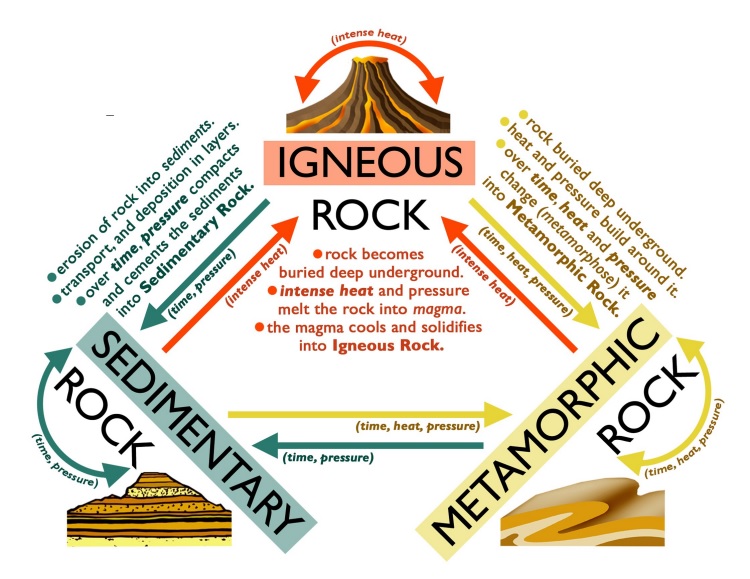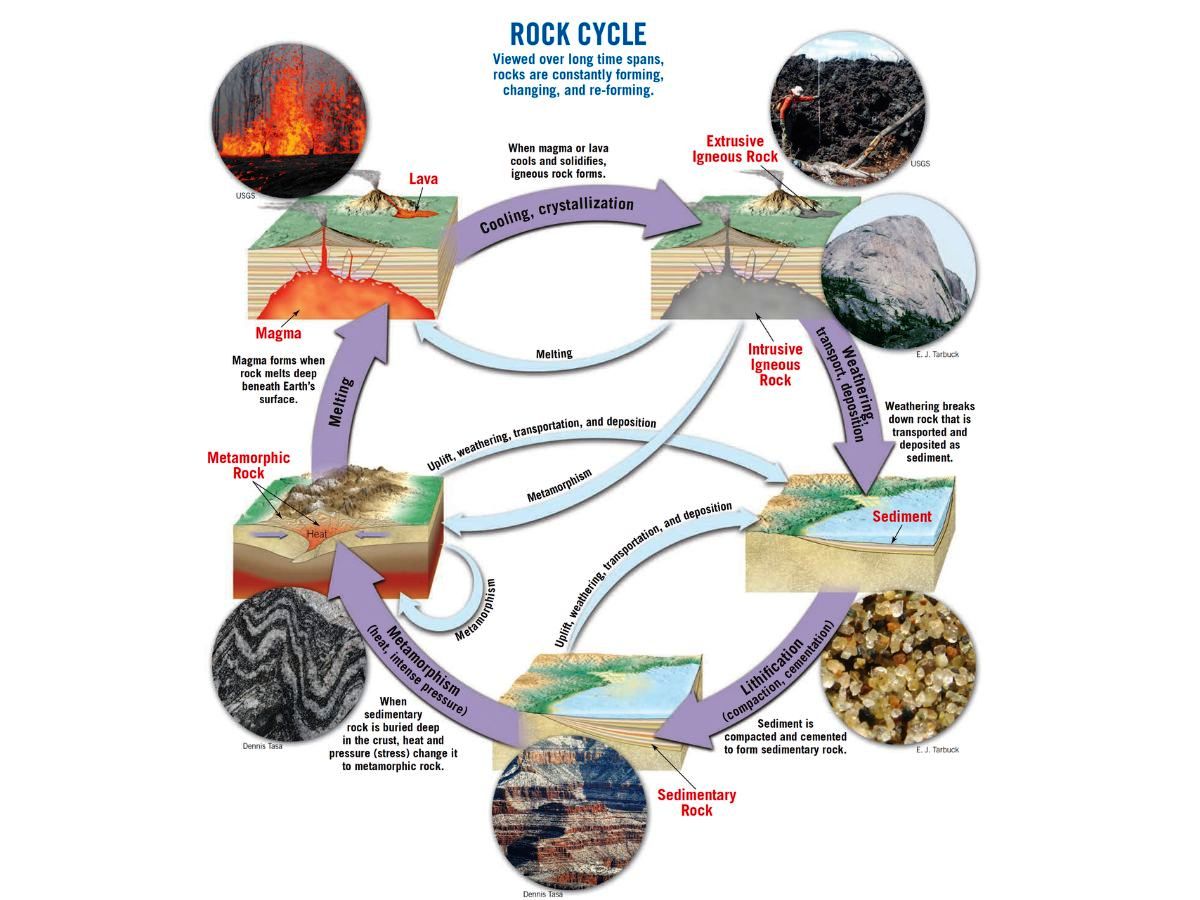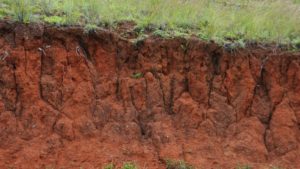The rock cycle

Introduction
The geological realm unfolds in a mesmerizing dance known as “The Rock Cycle.” In this intricate ballet of Earth’s crust, rocks undergo a perpetual transformation, shaping the very foundation of our planet. Let’s delve into the rhythmic progression of this geological masterpiece, exploring its significance and understanding the key processes that orchestrate the cycle.
What is the Rock Cycle?
The rock cycle is a dynamic and continuous process that illustrates the interplay between various rock types, highlighting their transformation through geological time. This geological symphony comprises three main stages: igneous, sedimentary, and metamorphic.
Igneous Stage: The Fiery Overture
At the genesis of the rock cycle, molten magma rises from the Earth’s mantle, either cooling and solidifying beneath the surface (intrusive) or erupting onto the surface as lava (extrusive). This process results in the formation of igneous rocks like granite, basalt, and obsidian.
Sedimentary Stage: The Gentle Interlude
Through weathering and erosion, igneous rocks break down into sediments, which then undergo compaction and cementation to form sedimentary rocks. Examples include limestone, sandstone, and shale, each telling a unique tale of Earth’s environmental history.
Metamorphic Stage: The Transformative Crescendo
Under intense heat and pressure, either from tectonic forces or proximity to molten magma, existing rocks undergo metamorphism, giving rise to metamorphic rocks. Marble, schist, and slate exemplify the profound alterations experienced during this metamorphic movement.
The rock cycle diagram
The Rock Cycle Diagram serves as a visual roadmap, vividly depicting the intricate journey of rocks through Earth’s dynamic processes. This illustrative tool captures the cyclical nature of rock transformation, encompassing three fundamental stages: igneous, sedimentary, and metamorphic.

Why is the Rock Cycle Important?
The rock cycle is the geological maestro that shapes landscapes, influences ecosystems, and harbors invaluable resources. Understanding its importance unveils the intricate tapestry woven by geological processes.
Geological Diversity and Landscapes
The rock cycle sculpts the diverse landscapes we witness today. From rugged mountain ranges to expansive plains, the continuous interplay of rock types molds the Earth’s surface, creating a geological gallery of breathtaking vistas.
Ecosystem Influence
Different rocks offer distinct soil compositions, influencing the flora that can thrive in a particular region. The rock cycle’s influence on soil development plays a pivotal role in determining the ecosystems that can flourish within a given geological setting.
Resource Formation and Availability
Many of the Earth’s precious resources, including minerals, metals, and fossil fuels, originate from the rock cycle. Understanding the cycle helps us locate and extract these resources responsibly, ensuring a sustainable approach to geological exploration.
Exploring the Rock Cycle in Detail
Now, let’s delve deeper into each stage of the rock cycle, examining the intricate processes and geological marvels associated with each.
Igneous Stage: Beneath the Surface
Intrusive igneous rocks, born beneath the Earth’s surface, showcase a unique array of textures and mineral compositions. Let’s explore some prominent examples:
| Rock Type | Composition | Texture |
|---|---|---|
| Granite | Quartz, Feldspar, Mica | Coarse-Grained |
| Diorite | Plagioclase, Hornblende | Coarse-Grained |
| Gabbro | Olivine, Pyroxene | Coarse-Grained |
Meanwhile, extrusive igneous rocks, emerging from volcanic eruptions, offer their own captivating characteristics:
| Rock Type | Composition | Texture |
|---|---|---|
| Basalt | Plagioclase, Pyroxene | Fine-Grained |
| Andesite | Plagioclase, Amphibole | Intermediate-Grained |
| Pumice | Glassy texture with vesicles | Porous and Lightweight |
Sedimentary Stage: A Tale of Deposition
Sedimentary rocks preserve clues about Earth’s history, with each layer representing a chapter in the geological narrative. Here are some noteworthy examples:
Limestone: Formed from marine organisms, limestone is a testament to ancient seas and their vibrant ecosystems.
Sandstone: Composed of sand-sized particles, sandstone often bears the imprints of wind or water currents that shaped its deposition.
Shale: Fine-grained and often exhibiting fissility, shale signifies quiet environments where fine sediment settled over time.
Metamorphic Stage: The Alchemical Transformation
Metamorphic rocks arise from the profound alterations experienced by pre-existing rocks. Here are notable examples and the conditions that give rise to them:
| Rock Type | Parent Rock | Metamorphic Conditions |
|---|---|---|
| Marble | Limestone | High heat and pressure, metamorphism in the Earth's mantle |
| Schist | Shale | Regional metamorphism, intense pressure and moderate heat |
| Slate | Shale | Low-grade metamorphism, minimal heat and pressure |
Conclusion: Harmonizing with Earth's Geological Rhythm
In conclusion, the rock cycle orchestrates a geological symphony, influencing our landscapes, ecosystems, and resource availability. Embracing the nuances of igneous, sedimentary, and metamorphic processes enhances our appreciation for the dynamic forces shaping our planet. As we navigate the intricate melodies of the rock cycle, we uncover the geological secrets that define Earth’s past, present, and future. Let this exploration serve as a guide, harmonizing our understanding with the rhythmic cadence of the ever-evolving geological masterpiece – the rock cycle.





